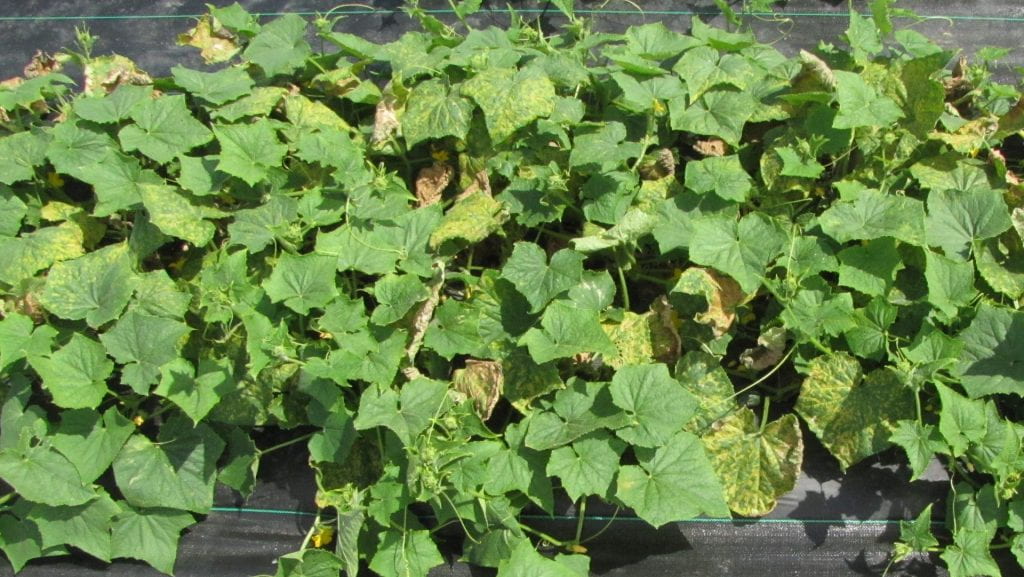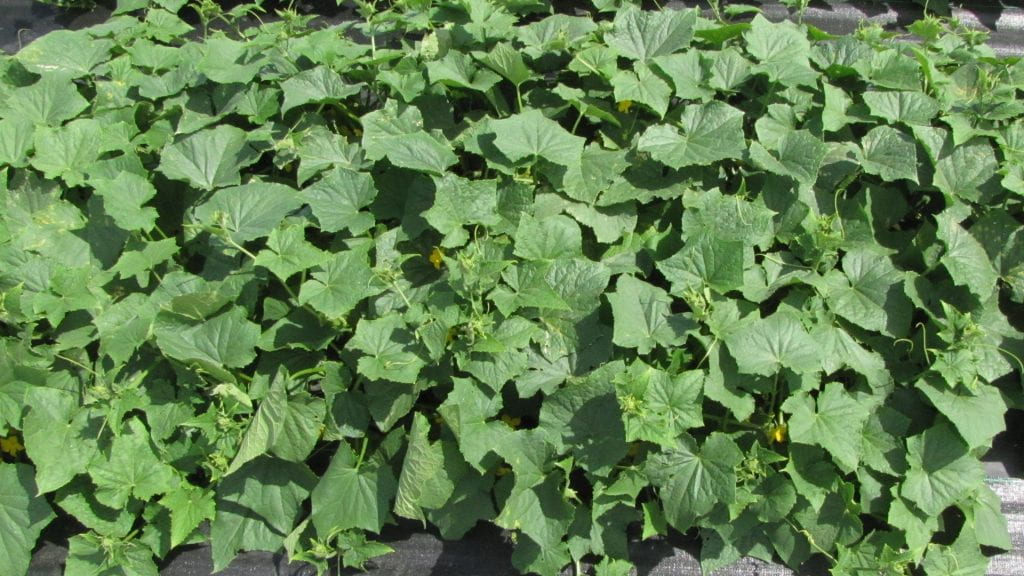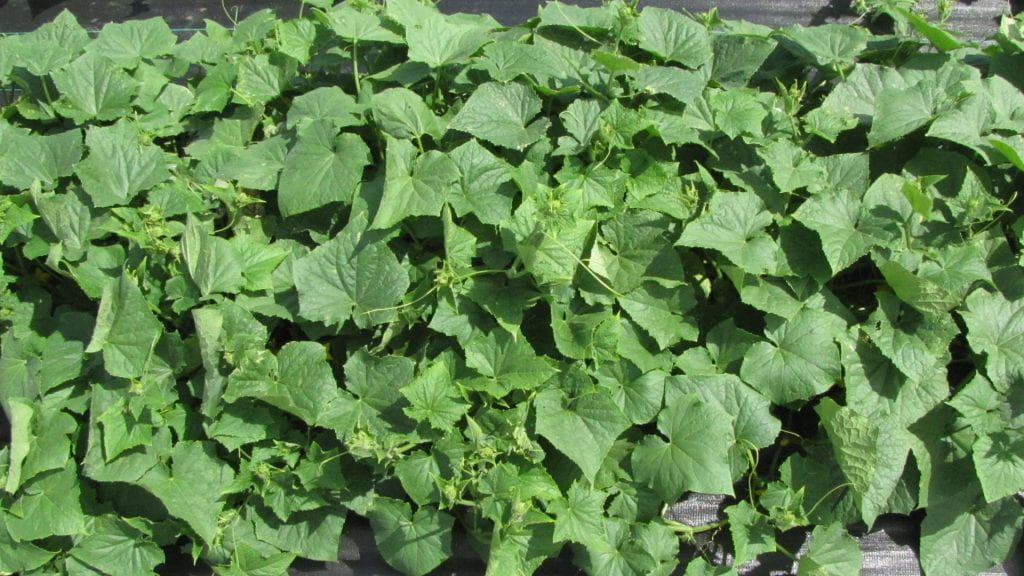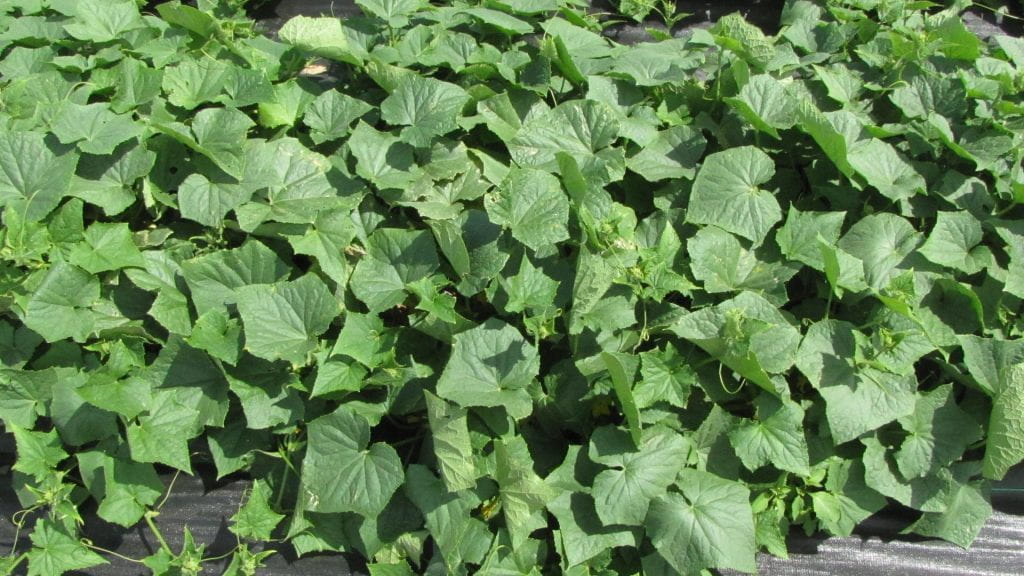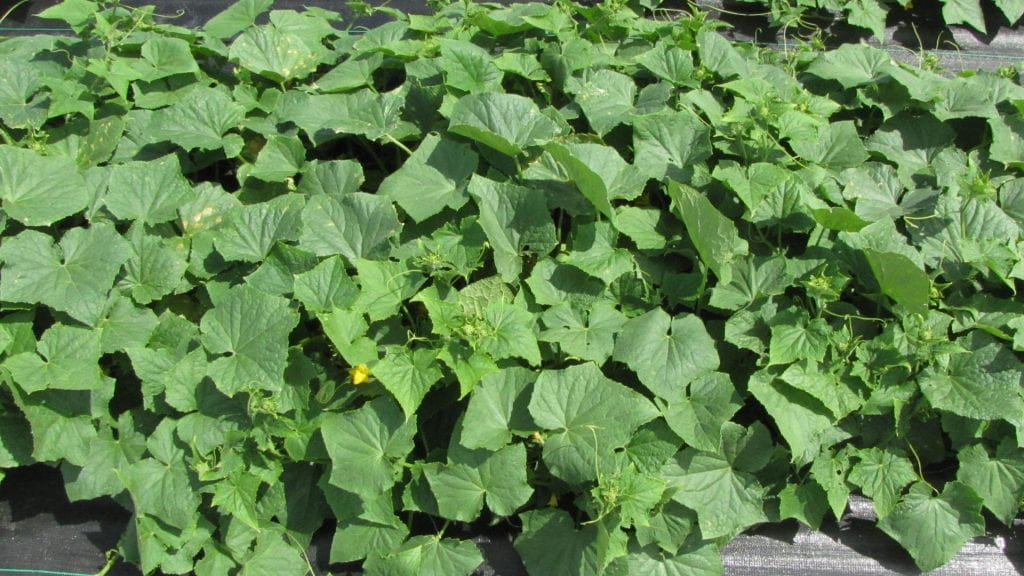Below are brief summaries of the main results from each experiment plus reference for a report published in Plant Disease Management Reports. Click on the publication year to download the report which has a table of results as well as detailed information about methods and results. Following the summaries, there are sections for each experiment with additional information about the experiment and results, treatment list, plus photographs of representative plots of each treatment.
2022: Theia, a new microbial-based biopesticide, was tested in 2 programs consisting of 2 preventive applications of Theia followed by 3 applications of conventional fungicides (Ranman and Orondis Ultra) and 3 of Theia. It was not evident that Theia improved control.
McGrath, M. T. and Downing, C. T. 2023. Efficacy of fungicide programs with a biopesticide and conventional fungicides for managing downy mildew in cucumber, 2022. Plant Disease Management Reports 17:V059.
2021: Howler and Theia, new microbial-based biopesticides, were tested applied in alternation with conventional fungicides (Ranman and Orondis Ultra). Downy mildew with both was numerically but not significantly less severe than on plants treated with similar programs with just these conventional fungicides applied on the same dates (14-day schedule) or with another conventional fungicide (Curzate) applied in place of the biopesticides. Severity was also numerically but not statistically lower with Timorex ACT (tea tree oil) applied with Ranman than for Ranman applied alone.
McGrath, M. T. and Downing, C. T. 2022. Efficacy of biopesticides applied with conventional fungicides for managing downy mildew in cucumber, 2021. Plant Disease Management Reports 16:V101.
Evaluations of Biopesticides with Conventional Fungicides, 2022.
The experiment was conducted in 2022 with ‘Marketmore 76’, a cucumber variety that has exhibited low level of resistance to the clade of the downy mildew pathogen affecting cucumber in the USA; it was bred to be resistant to the race that was dominant before 2004. Theia (active ingredient is Bacillus subtilis) was tested in 2 programs consisting of 2 preventive applications of Theia followed by 3 applications of conventional fungicides (Ranman and Orondis Ultra) and 3 of Theia in 2 different orders.
Treatment and amount/A (application week):
Theia 3 lb (1, 2, 6, 7, 8); Ranman 2.1 fl oz (3, 5); Orondis Ultra 8 fl oz (4)
Theia 3 lb (1, 2, 5, 7, 8); Ranman 2.1 fl oz (3, 6); Orondis Ultra 8 fl oz (4)
Ranman 2.1 fl oz (3, 5); Orondis Ultra 8 fl oz (4)
Ranman 2.1 fl oz (3, 6); Orondis Ultra 8 fl oz (4, 8); Previcur Flex 1.2 pt (5, 7)
Note: there were 4 additional treatments with just conventional fungicides not included here; see Report.
Symptoms of downy mildew were first observed in this experiment on one to five leaves in eight of the 36 plots on 8 August, which was 19 days after the first application. Symptoms were first observed on 5 August in an adjacent cucumber experiment. The first 3 applications were preventive because no symptoms were seen. Applications of conventional fungicides were started on 2 August because symptoms were found that day in the nearby sentinel plots for monitoring occurrence of cucurbit downy mildew, and there were high risk forecasts for successful spread of the pathogen to Long Island on 25 and 28 July, and 2 August.
The two programs with Theia, Ranman, and Orondis Ultra were effective, but it was not evident that this biopesticide improved control obtained with the conventional fungicides since there were no significant differences in downy mildew severity between the 2 treatments with Ranman and Orondis Ultra applied on the same dates (second and third treatments in the list above), which provided 52 and 46% control based on comparing AUDPC values (summation of severity over the assessment period) with the untreated control. The first treatment was significantly better than these (78% control). The most effective treatment (99% control) was the program with the fungicides Ranman, Orondis Ultra, and Previcur Flex applied in alternation every week. These conventional fungicides have targeted activity for downy mildew and related pathogens.
Images
The following photos were taken on 7 September, 7 days after the 7th application.
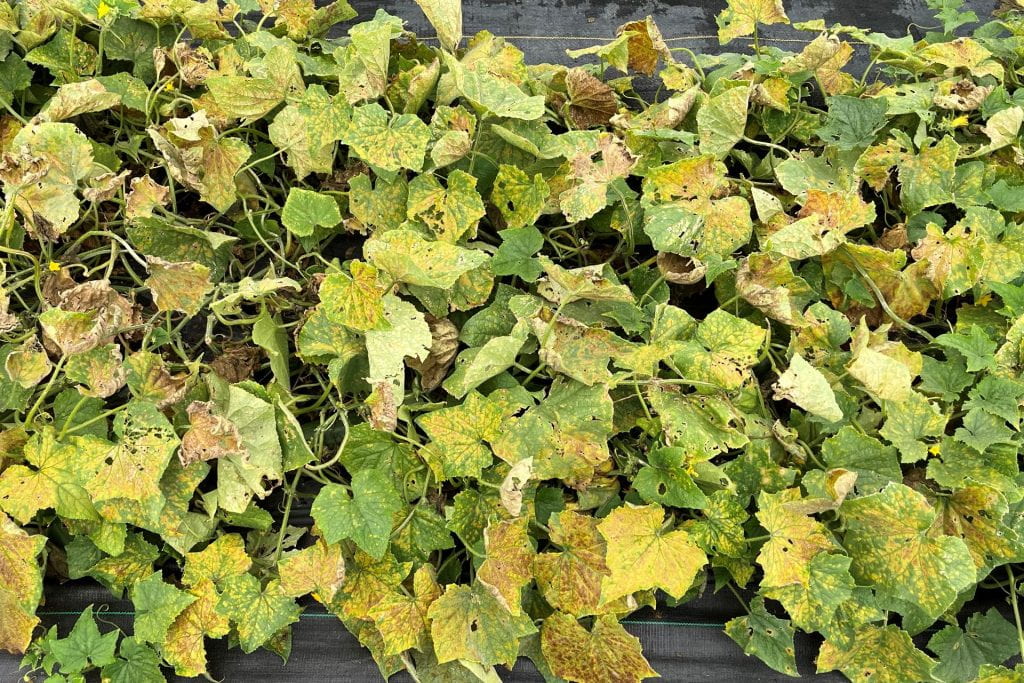

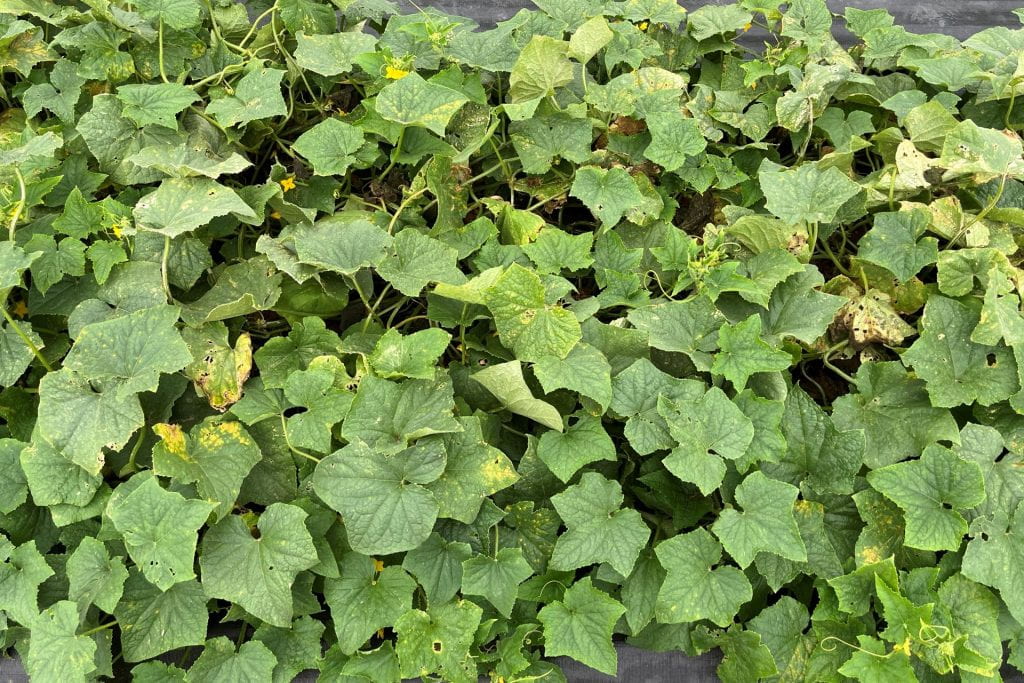
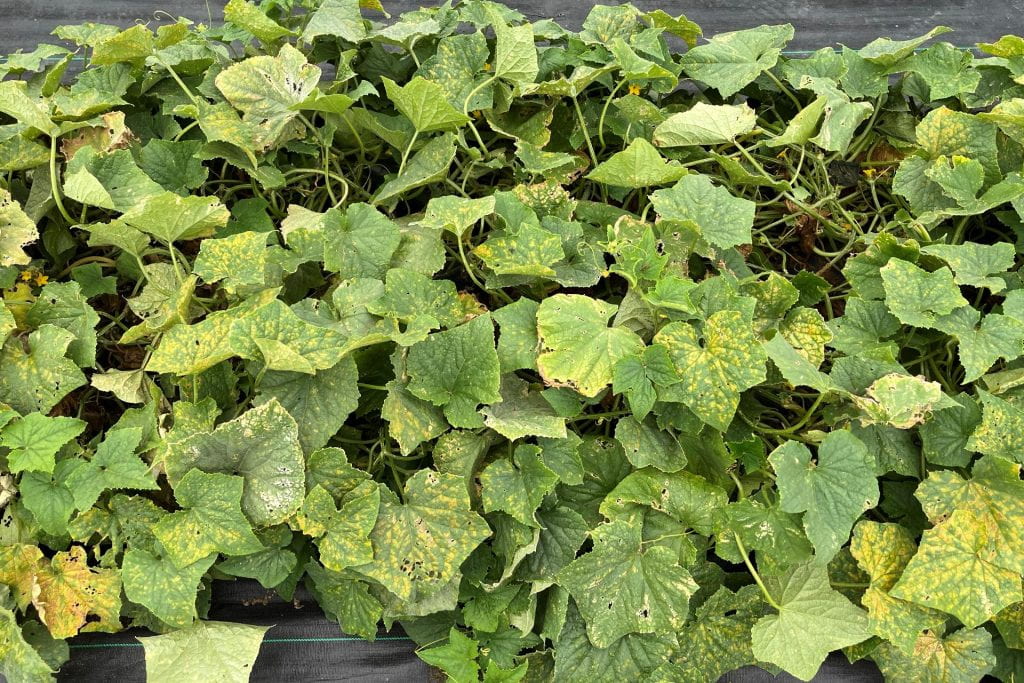

Evaluations of Biopesticides with Conventional Fungicides, 2021.
Treatment and amount/A (application week):
Orondis Ultra 8 fl oz (1, 7); Howler 5 lb (2, 4, 6); Ranman 2.1 fl oz (3, 5)
Orondis Ultra 8 fl oz (1, 7); Theia 3 lb (2, 4, 6); Ranman 2.1 fl oz (3, 5)
Orondis Ultra 8 fl oz (1, 7); Ranman 2.1 fl oz (3, 5)
Orondis Ultra 8 fl oz (1, 7); Ranman 2.1 fl oz (3, 5); Curzate 5 oz (2, 4, 6)
Ranman 2.1 fl oz + Timorex ACT 13.5 fl oz (1-7)
Ranman 2.1 fl oz + Timorex ACT 18 fl oz (1-7)
Ranman 2.1 fl oz (1-7)
Symptoms of downy mildew were first observed in this experiment in two of the 32 plots on 30 July, which was two days after the first application. All the treatments were effective based on canopy severity ratings and provided 69 – 95% control based on AUDPC values.
Severity was numerically but not statistically lower for the programs with Howler or Theia applied in rotation with two conventional fungicides (Orondis Ultra and Ranman) on a 7-day schedule than similar programs with just these conventional fungicides applied on the same dates (14-day schedule) or with another conventional fungicide (Curzate) applied in place of the biopesticides.
Severity was numerically but not statistically lower for Ranman applied with Timorex ACT than Ranman applied alone.
Images
The following photos were taken on 20 August, 3 days after the 4th application.
